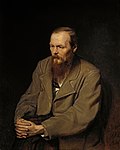Akira Kurosawa
Akira Kurosawa (March 23, 1910 – September 6, 1998)[1] was a Japanese movie director. Kurosawa's movies are liked in Japan. Kurosawa's movies are also liked by people in other countries. He made 30 movies in 50 years.[2] He is thought to be one of the most important movie directors.[3]
Akira Kurosawa 黒澤 明 | |
|---|---|
 | |
| Born | March 23, 1910 |
| Died | September 6, 1998 (aged 88) Setagaya, Tokyo, Japan |
| Occupation |
|
| Years active | 1936–1993 |
| Spouse(s) | Yōko Yaguchi (m. 1945–1985, her death); two children |
In many of his famous movies, including Rashomon and The Seven Samurai, he worked with the actor Toshiro Mifune.
Kurosawa started in the Japanese movie industry in 1936. Before he worked a little bit as a painter. After years of working on many movies as an assistant director and scriptwriter, he became a director in 1943. This was during World War II with the popular action movie Sanshiro Sugata (a.k.a. Judo Saga).
Rashomon, was first shown in Tokyo in August 1950. On September 10, 1951 it was the surprise winner of the Golden Lion at the Venice Film Festival. It then was shown in Europe and North America. Because the movie was so well liked, it made people in the western world want to see more Japanese movies. This helped make other Japanese movie makers become successful. In the 1950s and early 1960s, Kurosawa directed about one movie each year.
In 1990, he accepted the Academy Award for Lifetime Achievement.[4][5] After he died, he was named "Asian of the Century" in the "Arts, Literature, and Culture" category by AsianWeek magazine and CNN.[6]
Akira Kurosawa known for influential, character-rich films exploring morality, often collaborating with Toshiro Mifune. His work blends Japanese tradition with dynamic visuals, symbolism, and humanism.[7]
Akira Kurosawa Media
Filming of The Men Who Tread on the Tiger's Tail, 1945
Takashi Shimura played a dedicated doctor helping an ailing gangster in Drunken Angel. Shimura performed in over 20 of Kurosawa's films.
Toshiro Mifune, a frequent lead in Kurosawa's films, in 1954
Fyodor Dostoevsky wrote The Idiot, which Kurosawa adapted into a Japanese film of the same name in 1951. Perov's portrait from the 1800s
Kurosawa based his 1963 crime film High and Low on Ed McBain's novel King's Ransom. Image of McBain c. 1953
Sidney Lumet (pictured) successfully requested that Kurosawa be nominated as Best Director for his film Ran at the 58th Academy Awards; the award was won by Sydney Pollack.
Steven Spielberg, pictured here at the Cinémathèque Française in 2012, helped finance the production of several of Kurosawa's final films.
Throne of Blood cast and crew photo taken in 1956, showing (from left to right) Shinjin Akiike, Fumio Yanoguchi, Kuichiro Kishida, Samaji Nonagase, Takao Saito, Toshiro Mifune (in the jeep), Minoru Chiaki, Takashi Shimura, Teruyo Nogami, Yoshirō Muraki, Akira Kurosawa, Hiroshi Nezu, Asakazu Nakai, and Sōjirō Motoki
Kurosawa's kamon, used by several of his characters as their mon-tsuki
Ingmar Bergman, shown here in a bust located in Kielce, Poland, was an admirer of Kurosawa's work.
Related pages
References
- ↑ Akira Kurosawa on IMDb
- ↑ "BFI Features, Akira Kurosawa, a filmography". www.bfi.org.uk. Archived from the original on 2010-04-21. Retrieved 2010-02-22.
- ↑ "Greatest Film Directors and Their Best Films". www.filmsite.org. Retrieved 2010-02-22.
- ↑ "Academy Award Acceptance Speech Database". Archived from the original on 2010-02-17. Retrieved 2010-06-13.
- ↑ "Akira Kurosawa Tribute with George Lucas, Steven Spielberg". YouTube. 2008-11-19. Retrieved 2010-06-28.
- ↑ "ASIANOW – Asiaweek – Asian of the Century – Kurosawa Akira – 12/10/99". Archived from the original on 2013-06-03. Retrieved 2010-06-18.
- ↑ "10 Signature Elements of Akira Kurosawa's Filmmaking Style!". www.criticfilm.com. 2023-06-09. Retrieved 2023-10-23.
Other websites
| Wikimedia Commons has media related to Lua error in Module:Commons_link at line 62: attempt to index field 'wikibase' (a nil value).. |
- Akira Kurosawa's grave Archived 2016-02-28 at the Wayback Machine









